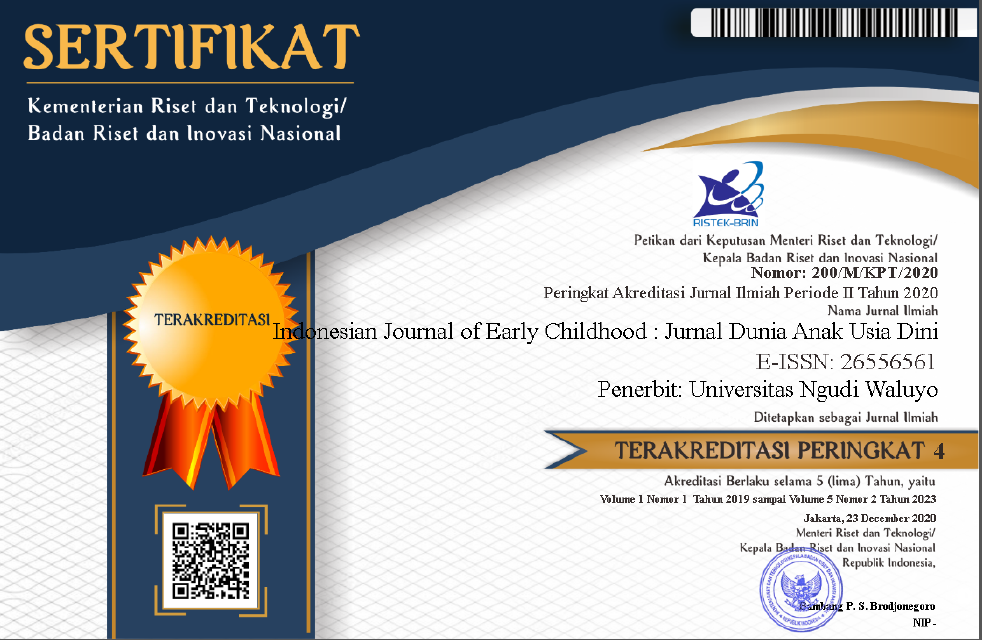Penerapan Project Based Learning untuk Meningkatkan Kreativitas Peserta Didik Kelompok B1 di TK Desa Gentan
Implementation of Project Based Learning to Increase the Creativity of Group B1 Students in Gentan Village Kindergarten
DOI:
https://doi.org/10.35473/ijec.v7i1.2877Keywords:
Project Based Learning, Kreativitas, Anak Usia 5-6 Tahun, Media Loose PartAbstract
This research aims to find out whether the application of the project based learning model can increase the creativity of children aged 5-6 years and how to increase the creativity of children aged 5-6 years through the project based learning model. This research was carried out at the Gentan Village Kindergarten. The method used is Classroom Action Research. Data collection is carried out through planning, action, observation and reflection. The subjects of this research were 15 children aged 5-6 years in group B1 at Gentan Village Kindergarten. From the research results, it was found that the creativity of children aged 5-6 years can be increased through the project based learning model. This was proven in cycle 1, the level of children's creativity was 39.31% and increased by 24.02% in cycle 2, namely to 63.33%, so the classroom action research was stopped at the stage of cycle 2. How to increase the creativity of children aged 5-6 years in Gentan Village Kindergarten through the application of a project based learning model with loose part media.
ABSTRAK
Penelitian ini bertujuan untuk mengetahui apakah penerapam model pembelajaran project based learning dapat meningkatkan kreativitas anak usia 5-6 tahun dan bagaimana cara meningkatkan kreativitas anak usia 5-6 tahun melalui model pembelajaran project based learning. Penelitian ini dilaksanakan di TK Desa Gentan. Metode yang digunakan ialah Penelitian Tindakan Kelas. Pengumpulan data dilakukan melalui perencanaan, tindakan, observasi, dan refleksi. Subyek penelitian ini adalah anak-anak usia 5-6 tahun kelompok B1 di TK Desa Gentan sebanyak 15 anak. Dari hasil penelitian didapatkan bahwa kreativitas anak usia5-6 tahun dapat ditingkatkan melalui model pembelajaran project based learning. Hal ini dibuktikan pada siklus 1 tingkat kreativitas anak sebesar 39,31% dan mengalami peningkatan sebanyak 24,02% pada siklus 2 yaitu menjadi 63,33%, sehingga penelitian tindakan kelas dihentikan pada tahapann siklus 2. Cara peningkatan kreativitas anak usia 5-6 tahun di TK Desa Gentan melalui penerapan model pembelajaran project based learning dengan media loose part.
References
Agustina, P. (2021). Contribution of Project Based Learning To the Stimulation of Early Children’S Creativity Development. Early Childhood Education and Development Journal, 3, 27–34. Retrieved from https://jurnal.uns.ac.id/ecedj
Amelia, N., & Aisya, N. (2021). Model Pembelajaran Berbasis Proyek (Project Based Learning) Dan Penerapannya Pada Anak Usia Dini Di Tkit Al-Farabi. BUHUTS AL- ATHFAL: Jurnal Pendidikan Dan Anak Usia Dini, 1(2), 181–199. https://doi.org/10.24952/alathfal.v1i2.3912
Fidiani, A., & Khabibah, U. (2023). Pemanfaatan Bahan Ajar Loose Part Melalui Model Pembelajaran Project Based Learning untuk Menstimulasi Kreativitas Anak Usia Dini di TK Baitul Ilmi. Indo-MathEdu Intellectuals Journal, 4(3), 2080-2086.
Handayani, A., & Sinaga, S. I. (2022). Penerapan Model Project Based Learning dalam Meningkatkan Kemampuan Berpikir Kritis Anak Usia Dini. PAUD Lectura :Journal of Early Childhood Education, 5(3), 146–155. https://doi.org/10.31849/paud-lectura.v
Nikmah, A., Shofwan, I., & Loretha, A. F. (2023). Implementasi Metode Project Based Learning untuk Kreativitas pada Anak Usia Dini. Jurnal Obsesi : Jurnal Pendidikan Anak Usia Dini, 7(4), 4857–4870. https://doi.org/10.31004/obsesi.v7i4.4999
Ningsih, R., Bachtiar, M. Y., & Indrawati, I. (2022). Meningkatkan Kreativitas Membuat Karya Seni pada Anak Usia Dini melalui Pembelajaran Project Based Learning TK Kurnia Simomulyo Baru Surabaya Jawa Timur. Jurnal Pemikiran Dan Pengembangan Pembelajaran, 4(2), 304-309
Palapessy, X., Ningrum, M. A., Adhe, K. R., & Widayanti, M. D. (2023). Analisis Project Based Learning (PjBL) Untuk Kemampuan Berpikir Kreatif Anak Usia 5-6 Tahun. PENDIPA Journal of Science Education, 7(3), 431-438.
Sakila, S. R., Hibana, H., & Tumbularani, T. (2023). Penerapan Model Pembelajaran Project Based Learning (Pjbl) dalam Implementasi Kurikulum Merdeka di Pendidikan Islam Anak Usia Dini. EDUKASIA: Jurnal Pendidikan dan Pembelajaran, 4(2), 2383-2392.
Sari, A. M., Suryana, D., Bentri, A., & Ridwan, R. (2023). Efektifitas Model Project Based Learning (PjBL) dalam Implementasi Kurikulum Merdeka di Taman Kanak-Kanak. Jurnal Basicedu, 7(1), 432–440. https://doi.org/10.31004/basicedu.v7i1.4390
Setiawan, L., Wardani, N. S., & Permana, T. I. (2021). Peningkatan kreativitas siswa pada pembelajaran tematik menggunakan pendekatan project-based learning. Jurnal Pembangunan Pendidikan: Fondasi Dan Aplikasi, 8(1), 1879–1887. https://doi.org/10.21831/jppfa.v8i2.40574
Wardhani, J. D., Katoningsih, S., & Asmawulan, T. (2023). Manfaat model Pembelajaran Project Based Learning untuk Pendidikan Anak Usia Dini dan Implementasinya dalam Kurikulum Merdeka. 9(2).
Wulandari, A., & Suparno, S. (2020). Pengaruh Model Problem Based Learning terhadap Kemampuan Karakter Kerjasama Anak Usia Dini. Jurnal Obsesi: Jurnal Pendidikan Anak Usia Dini, 4(2), 862-872.
Yuniharto, B. S., & Rochmiyati, S. (2022). Peningkatan Minat Belajar Dan Kreativitas Melalui Project Based Learning Pada Siswa Kelas V Sdn Sariharjo. Autentik : Jurnal Pengembangan Pendidikan Dasar, 6(2), 226–235. https://doi.org/10.36379/autentik.v6i2.225
Yuliantina, I., & Yuliati, D. A. T. (2023). Model Pembelajaran Berbasis Projek dalam Meningkatkan Kreativitas Anak Usia Dini. JIIP - Jurnal Ilmiah Ilmu Pendidikan, 6(11), 9143–9148. https://doi.org/10.54371/jiip.v6i11.2934
Maulidah, E. (2021). Keterampilan 4C Dalam Pembelajaran Untuk Anak Usia Dini.
Childhood Education : Jurnal Pendidikan Anak Usia Dini, 2(1), 52–68. https://doi.org/10.53515/cji.2021.2.1.52-68
Downloads
Published
How to Cite
Issue
Section
License
Copyright (c) 2025 Indonesian Journal of Early Childhood: Jurnal Dunia Anak Usia Dini

This work is licensed under a Creative Commons Attribution-ShareAlike 4.0 International License.
Please find the rights and licenses in Indonesian Journal Of Early Childhood: Jurnal Dunia Anak Usia DIni. By submitting the article/manuscript of the article, the author(s) agree with this policy. No specific document sign-off is required.
1. License
The non-commercial use of the article will be governed by the Creative Commons Attribution license as currently displayed on Creative Commons Attribution-ShareAlike 4.0 International License.
2. Author(s)' Warranties
The author warrants that the article is original, written by stated author(s), has not been published before, contains no unlawful statements, does not infringe the rights of others, is subject to copyright that is vested exclusively in the author and free of any third party rights, and that any necessary written permissions to quote from other sources have been obtained by the author(s).
3. User Rights
Indonesian Journal Of Early Childhood: Jurnal Dunia Anak Usia Dini's spirit is to disseminate articles published are as free as possible. Under the Creative Commons license, Indonesian Journal Of Early Childhood: Jurnal Dunia Anak Usia Dini permits users to copy, distribute, display, and perform the work for non-commercial purposes only. Users will also need to attribute authors and Indonesian Journal Of Early Childhood: Jurnal Dunia Anak Usia Dini on distributing works in the journal and other media of publications.
4. Co-Authorship
If the article was jointly prepared by more than one author, any authors submitting the manuscript warrants that he/she has been authorized by all co-authors to be agreed on this copyright and license notice (agreement) on their behalf, and agrees to inform his/her co-authors of the terms of this policy. Indonesian Journal Of Early Childhood: Jurnal Dunia Anak Usia Dini will not be held liable for anything that may arise due to the author(s) internal dispute. Indonesian Journal Of Early Childhood: Jurnal Dunia Anak Usia Dini will only communicate with the corresponding author.
5. Miscellaneous
Indonesian Journal Of Early Childhood: Jurnal Dunia Anak Usia Dini will publish the article (or have it published) in the journal if the article’s editorial process is successfully completed. Indonesian Journal Of Early Childhood: Jurnal Dunia Anak Usia Dini's editors may modify the article to a style of punctuation, spelling, capitalization, referencing and usage that deems appropriate. The author acknowledges that the article may be published so that it will be publicly accessible and such access will be free of charge for the readers as mentioned in point 3.
Â
Every accepted manuscript should be accompanied by "Copyright Transfer Agreement" prior to the article publication.



